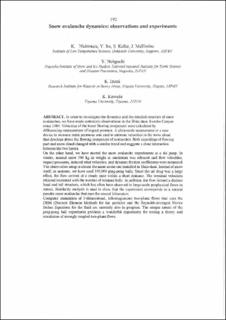| dc.description.abstract | In order to investigate the dynamics and the detailed structure of snow avalanches, we have made systematic observations in the Shiai-dani, Kurobe Canyon since 1989. Velocities of the lower flowing component were calculated by differencing measurement of impact pressure. A ultra-sonic anemometer or a new device to measure static pressures was used to estimate velocities in the snow cloud that develops above the flowing component of avalanches. Both recordings of flowing part and snow cloud changed with a similar trend and suggests a close interaction between the two layers. On the other hand, we have started the snow avalanche experiments at a ski jump. In winter, natural snow 300 kg in weight at maximum was released and flow velocities, impact pressures, induced wind velocities, and dynamic friction coefficients were measured. The observation setup is almost the same as the one installed in Shiai-dani. Instead of snow itself, in summer, we have used 350,000 ping-pong balls. Since the air drag was a large effect, the flow arrived at a steady state within a short distance. The terminal velocities attained increased with the number of released balls. In addition, the flow formed a distinct head and tail structure, which has often been observed in large-scale geophysical flows in nature. Similarity analysis is used to show that the experiment corresponds to a natural powder snow avalanche that runs for several kilometers. Computer simulation of 3-dimensional, inhomogeneous two-phase flows that uses the DEM (Discrete Element Method) for the particles and the Reynolds-averaged Navier Stokes Equations for the fluid are currently also in progress. The unique nature of the ping-pong ball experiment provides a wonderful opportunity for testing a theory and simulation of strongly coupled two-phase flows. | en_US |
